1. 响应式编程概述
响应式编程(Reactive Programming)是一种基于异步数据流和事件驱动的声明式编程范式。它强调以数据流的形式处理异步事件,广泛应用于 GUI 编程、Web 编程、微服务架构,乃至整个响应式系统(Reactive Systems)的设计中。
与传统的命令式编程不同,响应式编程更关注“数据如何变化”而不是“如何操作数据”。它通过观察者模式(Observer Pattern)和函数式编程的思想,构建出更清晰、更可维护的异步逻辑。
2. 响应式编程的起源
最早的 GUI 程序采用的是同步事件处理机制:用户点击按钮后,程序才会更新界面。这种模型的核心是一个“事件循环(Event Loop)”,它不断等待用户输入并更新界面。
但这种同步等待的方式会导致界面卡顿,用户体验差。为了解决这个问题,引入了事件队列(Event Queue) 和生产者-消费者模式(Producer-Consumer Pattern):
- 用户输入作为生产者,将事件放入队列;
- 界面更新线程作为消费者,从队列中取出事件进行处理。
这种解耦方式催生了响应式流(Reactive Streams)的概念。
如今,响应式编程已广泛应用于云服务和微服务架构中。微服务之间通过异步消息传递通信,而响应式编程正是这种异步通信的理想选择。
3. 响应式编程框架
目前主流的响应式编程框架包括:
- RxJava:2013 年推出,是最早的响应式库之一,适用于 Java。
- Project Reactor:Spring 5 的响应式核心库,支持 Reactor Netty、WebFlux 等。
- Akka Streams:基于 Actor 模型,适合构建高并发、分布式的响应式系统。
- Vert.x:轻量级响应式框架,适用于构建事件驱动的网络应用。
此外,Reactive Streams 是一个标准化的响应式流 API,旨在统一异步流处理的标准,并支持背压(Back Pressure)机制。
4. 观察者模式(Observer Pattern)
响应式编程的核心是异步通信,其底层实现依赖于观察者模式。
在传统的同步调用中,调用者必须等待方法返回结果。而在异步通信中,调用者注册一个回调函数,当结果可用时自动触发。这种方式允许调用者继续执行其他任务,提高了并发性和响应性。
在响应式编程中,异步调用的返回值称为 Observable,而回调函数称为 Observer。如下图所示:
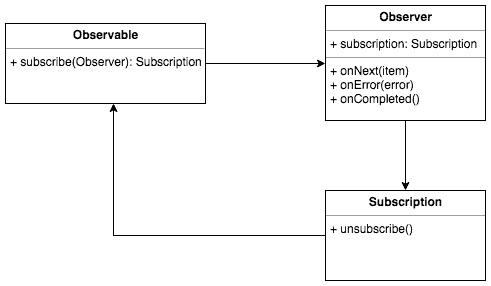
但使用回调函数会带来“回调地狱(Callback Hell)”,尤其是当多个异步操作嵌套时。响应式编程通过操作符链(Operator Chaining)解决了这个问题。
5. 响应式流(Reactive Streams)
响应式应用通常处理的不是一个事件,而是一系列连续的事件流。此时,Observable 不再只是一个值,而是一个事件流(Event Stream),Observer 需要处理流的开始、结束和错误。
响应式流的传输方式主要有两种:
| 类型 | 描述 |
|---|---|
| Push | 数据由生产者主动推送给消费者,消费者可能被大量数据淹没,需要背压机制控制流速 |
| Pull | 消费者主动请求下一个事件,更易于控制流速 |
6. 响应式流操作符(Operators)
响应式流的强大之处在于其提供的丰富操作符(Operators)。这些操作符封装了常见的异步流处理逻辑,如过滤、映射、聚合等。而且它们支持链式调用,形成处理流水线。
我们以 RxJava 为例,介绍几种常用操作符类型。
6.1 创建操作符(Creation Operators)
用于创建数据流。例如:
Observable<String> workdays = Observable.fromArray("Monday", "Tuesday", "Wednesday", "Thursday", "Friday");
workdays.subscribe(
day -> System.out.println(day),
error -> System.out.println("Error: " + error),
() -> System.out.println("Stream completed.")
);
对应图表:

6.2 合并创建操作符(Join Creation Operators)
用于合并多个流。例如 concat():
Observable<String> source1 = Observable.just("10", "20", "30", "40", "50");
Observable<String> source2 = Observable.just("11", "21", "31", "41", "51");
Observable<String> source3 = Observable.just("12", "22", "32", "42", "52");
Observable<String> source = Observable.concat(source1, source2, source3);
source.subscribe(
s -> System.out.println(s),
error -> System.out.println("Error: " + error),
() -> System.out.println("Stream completed.")
);
对应图表:
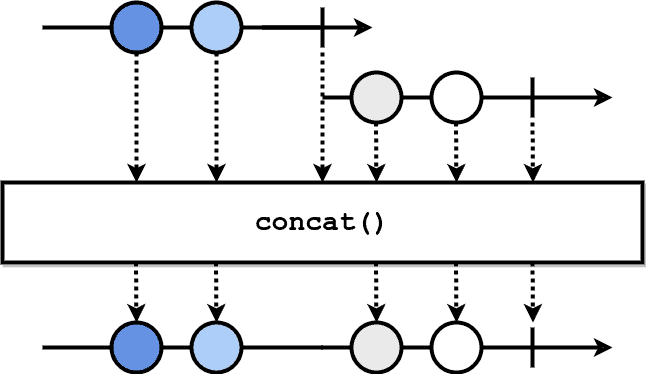
6.3 转换操作符(Transformation Operators)
用于转换流中的数据。例如 map():
Observable<Integer> source = Observable.just(1, 2, 3, 4, 5);
source.map(x -> 10 * x).subscribe(
n -> System.out.println("Value: " + n),
error -> System.out.println("Error: " + error),
() -> System.out.println("Stream completed.")
);
对应图表:
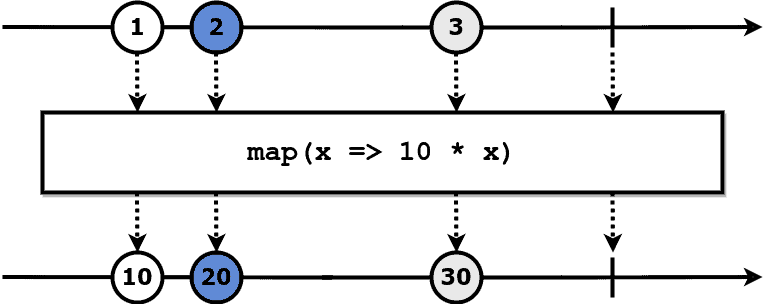
6.4 过滤操作符(Filtering Operators)
用于筛选符合条件的数据。例如 filter():
Observable<Integer> source = Observable.just(2, 30, 22, 5, 60, 1 );
source.filter(x -> x > 10).subscribe(
n -> System.out.println("Value: " + n),
error -> System.out.println("Error: " + error),
() -> System.out.println("Stream completed.")
);
对应图表:
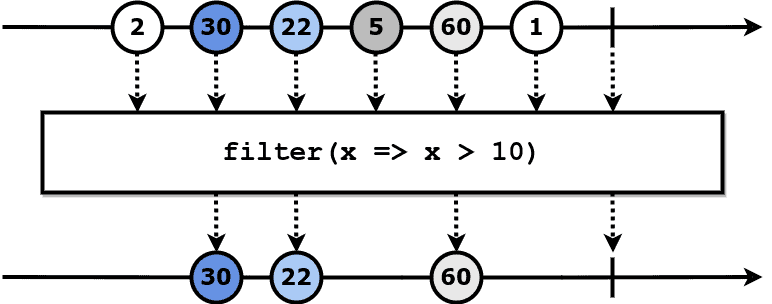
6.5 合并操作符(Join Operators)
用于合并两个流。例如 merge():
Observable<String> numbersSource = createStreamFrom("1 2 3 4 5", 0, 200, TimeUnit.MILLISECONDS);
Observable<String> lettersSource = createStreamFrom("A B C", 500, 500, TimeUnit.MILLISECONDS);
Observable<String> source = Observable.merge(lettersSource, numbersSource);
source.subscribe(
x -> System.out.println("Merge value: " + x),
error -> System.out.println("Error: " + error),
() -> System.out.println("Stream completed.")
);
对应图表:
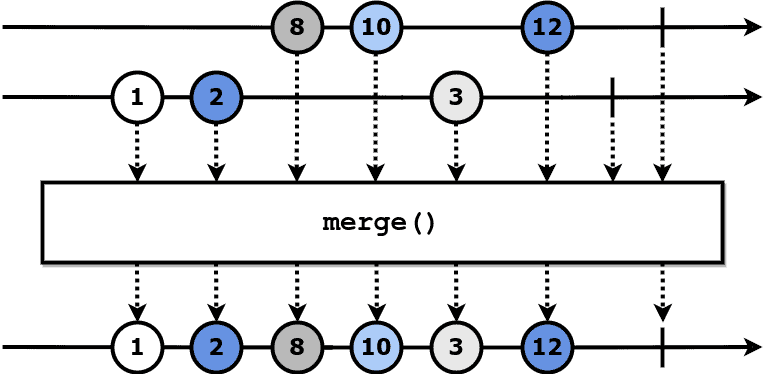
6.6 多播操作符(Multicasting Operators)
用于多个订阅者共享一个流:
- Cold Publisher:每个订阅者从头开始接收数据(如
replay()) - Hot Publisher:订阅者只能接收订阅后的新数据(如
publish())
示例(Cold):
Observable<String> coldPublisher = numbersSource.replay().autoConnect();
coldPublisher.subscribe(...);
示例(Hot):
Observable<String> hotPublisher = numbersSource.publish().autoConnect();
hotPublisher.subscribe(...);
对应图表:
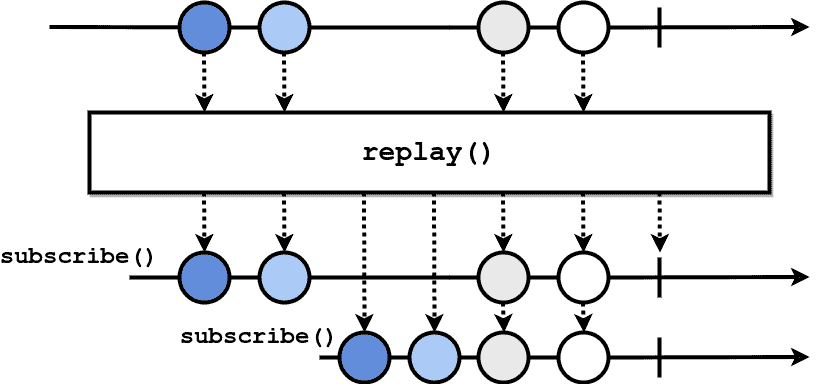
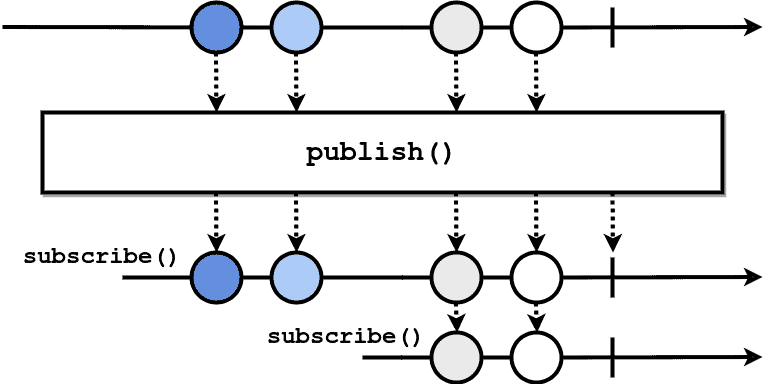
6.7 错误处理操作符(Error Handling Operators)
用于处理流中的错误:
onErrorReturnItem():发生错误时返回默认值onErrorResumeWith():发生错误时切换到另一个流
示例:
Observable<Integer> result = numbers.map(x -> 20 / x).onErrorReturnItem(-1);
result.subscribe(...);
7. 响应式编程实战:增量搜索
以增量搜索(Incremental Search)为例,说明响应式编程的实际应用。
场景描述
用户在搜索框中输入字符时,实时发起请求搜索结果。为避免频繁请求,我们希望:
- 输入时暂停请求
- 停止输入 500ms 后再发起请求
- 若在请求未完成时再次输入,则取消前一次请求
实现步骤
- 创建输入流:
TextField textfield = new TextField("", 20);
frame.add(textfield);
Observable<String> userInput = Observable.create(emitter -> {
textfield.addTextListener(new TextListener() {
public void textValueChanged(TextEvent e) {
emitter.onNext(textfield.getText());
}
});
});
- 构建响应式处理链:
userInput.debounce(500, TimeUnit.MILLISECONDS)
.filter(query -> query.length() > 3)
.distinctUntilChanged()
.switchMap(query -> searchService.search(query))
.subscribe(
results -> parseAndDisplayResults(listBox, results),
error -> System.out.println("Error: " + error)
);
对应图表
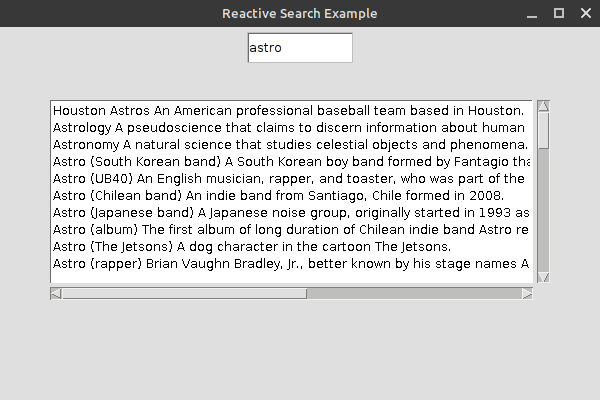
8. 响应式应用的测试与调试
测试
响应式应用的测试需要验证流是否按预期输出。常用工具包括:
- StepVerifier(Project Reactor)
- TestPublisher(Project Reactor)
- RxJava TestScheduler
测试内容包括:
- 正常完成
- 异常完成
- 被动取消
调试
响应式流的调试较为困难,因为异常堆栈通常指向订阅者,而非实际出错的操作符。建议使用以下方法:
- 使用
doOnNext()、doOnError()等调试操作符 - 使用
log()查看流的生命周期 - 在 IDE 中使用响应式调试插件(如 Reactor Tools)
9. 响应式编程优缺点总结
| 优点 ✅ | 缺点 ❌ |
|---|---|
| 异步逻辑清晰简洁 | 学习曲线陡峭 |
| 提供丰富操作符 | 调试困难 |
| 更具弹性、可扩展性、响应性 | 内存消耗较高 |
10. 总结
响应式编程是一种强大的异步编程范式,适用于构建高并发、事件驱动的应用程序。它通过响应式流和操作符链简化了异步逻辑,使代码更易维护和扩展。
尽管调试复杂度较高,但其在现代微服务架构和前端开发中的广泛应用,使其成为现代开发不可或缺的一部分。掌握响应式编程思想,有助于构建更健壮、高效的系统。